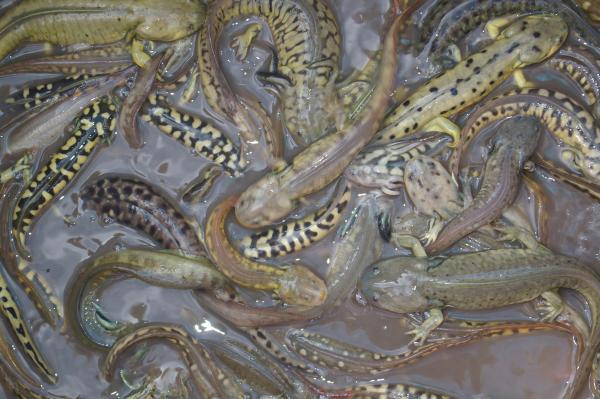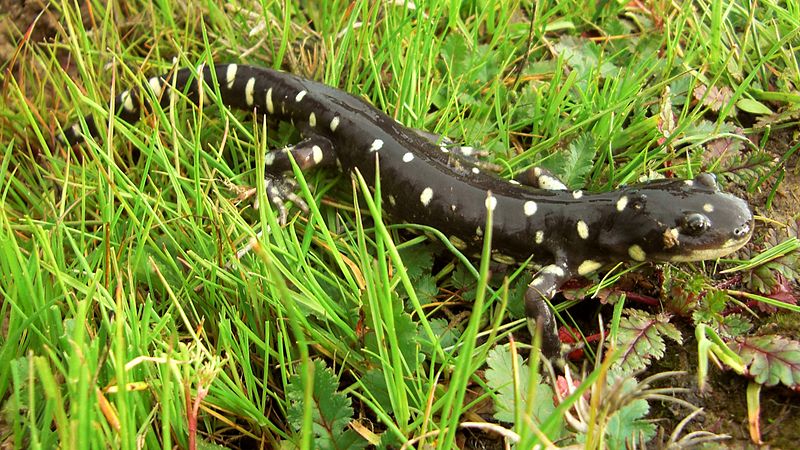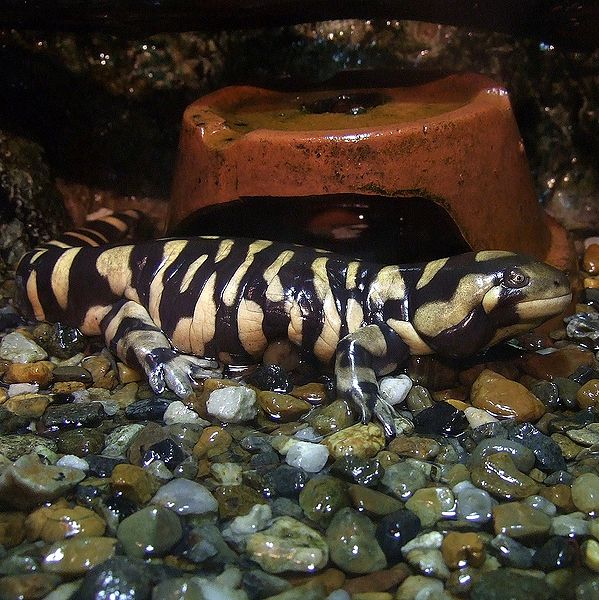Protecting endangered species is tough enough when it’s not easy to agree on what’s endangered and what’s not. But what about cases where it’s tough to define “species”?
California tiger salamanders (Ambystoma californiense), a threatened native species, has had to contend with an unwelcome house guest, the barred tiger salamander (Ambystoma mavortium) for over 60 years. But its plight is complicated by the fact that hybrids of the two species are thriving and producing animals that are a genetic mishmash.
Escapees from fishbait dealers in the 1950s and 1960s, barred tiger salamanders began breeding with the native California tiger salamanders in the wild. Now, sixty years later, the native salamander is a threatened species and “there aren’t any pure natives left in Salinas Valley,” says Maureen Ryan of the University of Washington ecologist who studies California tiger salamanders. Salinas Valley is the heart of the “hybrid zone” where crossbred offspring are found. Hybrids make up about a fifth of the total California tiger salamander population.
In recent years, Ryan and her colleagues at UC Davis and Western Kentucky University have found that hybrid salamanders are supersized version of their parents. They’re bigger, more voracious, gobbling up the insect and tadpole food supply, and turn to cannibalism if food runs out.
Moreover, they seem to adapt better than natives to poor water quality conditions caused by agricultural run-off that plague the Salinas Valley.
In December, the U.S. Fish and Wildlife Service announced it will develop recovery plans for three distinct populations of California tiger salamanders in Santa Barbara, Central California and Sonoma. Final plans should be in place by 2017. The hybrids, though, add a twist to the plans for the native salamanders’ recovery.
For now, hybrids are protected under the same umbrella as native tiger salamanders. But hybrids are elbowing native tiger salamanders out of their niche. Simply cutting them out of the will, and de-listing the hybrids has consequences of its own. Ryan explains, “If you delist them [hybrids], then anybody who wants to can go scoop up some introduced salamanders, throw them into any pond they want, and that would essentially delist that pond.”
It’s a critical point the recovery plan team is grappling with. “It’s a biological question as well as a political question,” said Ryan.
So can we just round up the hybrids and get rid of them? Well, not realistically. Tiger salamanders live longer than most house pets — 12 to 15 years in the wild — and spend most of the year in underground burrows.

Barred, California and hybrid tiger salamanders in a shallow pool
Tiger salamanders aren’t the only species grappling with the consequences of native and invasive specie
s mingling. Near Davis, in Yolo County, native butterflies have become so dependent on invasive plants, that entomologist Art Shapiro argues if people remove certain weeds, some native butterfly populations would disappear. There have been reports of hybrid polar bear and grizzly bears — “grolar bears” — a result of warming northern climates.
“I can’t articulate what a big question that is right now. Wildlife management in the 21st century: we’re
dealing with situations our laws aren’t equipped to deal with,” said Ryan.
She says there are plans to contain the hybrid salamander population, though they’ll probably have some kind of protected status as well.
Let’s just hope the California tiger salamander doesn’t go the way of the Mexican duck, which was removed from the endangered species list when its progeny became indistinguishable from Mallard ducks.

